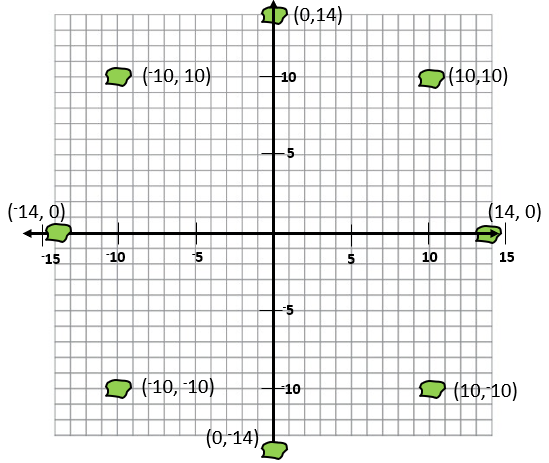This unit examines the use of rotation to specify angles as an amount of turn. The context of the unit, irrigating trees, requires the calculation of lengths and measurement of angles based on a four-quadrant number plane.
- Identify the location of a point on a four-quadrant number plane using coordinates.
- Average the x and y values of a set of coordinates to locate the centroid of the points.
- Use scale or Pythagoras’ Theorem to find the distance between points on a number plane.
- Measure the bearing (angle clockwise) for on point to another using a protractor.
This unit looks at the representation of locations of points on a four-quadrant number plane. Coordinates, or ordered pairs, give the horizontal and vertical distance of the point from an origin (0, 0). Like the starting point on a ruler, the choice of origin is set for a purpose, or for convention so all people use the same position as a starting point. For example, on the number plane below the point (5,11) is located 5 measures to the right of, and 11 measures up from, the origin. The point (-10, 3) is located 10 measures to the left of, and 3 measures up from, the origin. The first number in a coordinate, the x-value, always gives the horizontal measure and the second number, the y-value, always gives the vertical measure.
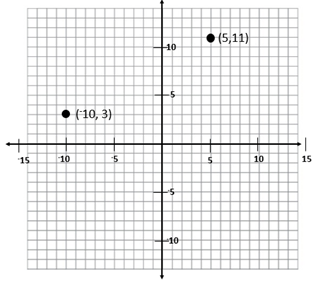
The learning opportunities in this unit can be differentiated by providing or removing support to students and by varying the task requirements. Ways to differentiate include:
- Using grid/graph paper to create co-ordinate systems and label the axes before expecting students to image the system.
- Providing students with physical and digital experiences that require moving in directions with distance, e.g., Turtle maths, Scratch.
- Explicitly teach students that angle is a measure of turn, how to use a protractor to measure and angle, the relationship of squares and square roots to area and side length, and how to find the square and square roots of integers (excluding roots of negative integers).
- Use calculators to ease the burden of calculation and encourage conceptual thinking.
- Put students in mixed ability groups for mutual support.
- Provide digital tutorials by looking online for videos on using scale maps and compass directions.
The context for this unit is about irrigating trees on a lifestyle block. You might choose to base the story on a different location that has meaning to your students, such as a local marae, park, gardens, or school grounds. The idea of imposing a coordinate plane on a location is easy using tools like Google Maps. Students may be interested in locations from different parts of the world, such as the location of island nations in the Pacific Ocean, or major landmarks in Europe.
Session One: Irrigating the trees
- Discuss:
What is meant by the word “irrigation”?
Why is irrigation important? - Introduce the story of Kylie and Gary using PowerPoint One. On Slide Four hold animating the coordinate plane. It appears when you mouse click.
Gary wants to install a single spray jet in the middle of these kōwhai trees.
Where should he locate the jet? How do you know?
Click to superimpose the coordinate plane.
How can we describe the position of each tree?
Ask students to write the coordinates for each tree.
Where is the centre of the five trees? How do you know? - The coordinates of the trees are (-10, 4), (-7, 0), (2, -8), (6, -3), (9, 7). The centroid of the points is found by averaging the x and y values. Take the x values. What is the average of -10, -7, 2, 6, and 9? Adding the numbers gives zero. Since 0 ÷ 5 = 0 the centroid occurs when x = 0, somewhere on the y-axis.
The average of the y values is also zero, since 4 + 0 + -8 + -3 + 7 = 0. Therefore (0, 0) is the centroid of the five trees and the best place to locate the jet. - Show Slide Five.
Gary needs to instruct the jet where to spray. The control unit needs an angle, clockwise, and a distance.
Animate the turn to the first tree.
What is the angle Gary needs to use? How did you estimate the angle?
Note the actual angle is 52.125⁰ but an estimate of a bit more than 45⁰ is excellent. - Give each student Copymaster One and ask them to estimate the angle needed to instruct the jet for each tree. Roam the room as they work. Look for the following:
- Do students have a sense of benchmark angles like 90⁰, 180⁰, 270⁰, 360⁰, and 45⁰?
- Do students use combinations of the benchmark angles to calculate a measure of turn for each tree?
- Students should share their estimates in pairs or threes and justify the angle they chose for each tree.
They can use a protractor to measure the angles accurately and check their estimates. - Gary also needs to work out the distance that the water jet needs to travel. If each unit is one metre how far is each tree from the jet?
- Let students work out ways to calculate the distance between the jet and each tree. Since the scale is on Copymaster One is about 0.8cm: 1m or 8mm:1m students might measure the distances in centimetres and do a conversion to metres.
What do you multiply the map length in centimetres by to get the distance in metres? Since 1 ÷ 0.8 = 1.25 use a factor of 1.25. That will give an approximate distance. - Look up Pythagoras Theorem online. Some students may have heard of the theorem though it is not usually taught until Level 5. The calculations are easy with a calculator. For example, the distance from the jet at (0, 0) to the tree in the first quadrant (top right).
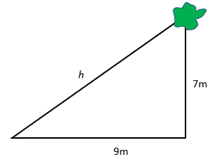
The x-value (9) and the y-value (7) give the lengths of the two shortest sides of the right-angled triangle. Pythagoras’ Theorem states that:
h2 = 92 + 72
h2 = 81 + 49 = 130
h = √130 = 11.4m - Ask students to apply Pythagoras’ Theorem to find to length of spray needed to the other trees.
Session Two: Applying angle and distance
- Copymaster One has a second page that is a blank grid. Model the activity you want students to engage in using PowerPoint Two.
Slide One shows the location of three trees that Kylie wants to irrigate.
Where should Kylie install the jet?
Let students suggest where to locate the jet. There is likely to be some variation.
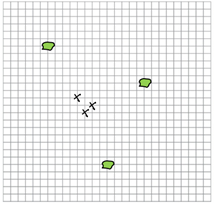
- How might Kylie accurately find the right location for the jet?
Let students suggest ways to find the centroid of the points.
Slide two takes an arbitrary centre and super-imposes a coordinate plane using that point as (0, 0).
Is (0, 0) the centroid? Find a way to check.
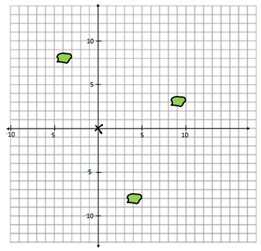
Suggest students start by finding the coordinates of the trees, given the arbitrary (no pun intended) choice for the origin (0, 0).
Watch that students use the correct direction for each value in the coordinates. The coordinates are shown with mouse clicks to be (-4, 8), (4, 3), and (9, -8).
Averaging the x-values gives (-4 + 4 + 9) ÷ 3 = 3.
Averaging the y-values gives (8 + 3 + -8) ÷ 3 = 1.
The point (3, 1) is the centroid of the three trees. A mouse click reveals this better location for the irrigation jet (0, 0). - Follow a similar process using Slides Three and Four of PowerPoint Two. In that case there are four trees and the arbitrary point chosen for (0, 0) is the centroid.
Do students appear to balance x and y values in their predictions of the centroid? - Ask students to use the blank grid on Copymaster One to do the following:
- Draw up to eight trees on the grid. Make sure to locate the trees in ‘crosshairs’ of the grid so they will be at whole number coordinates.
- Give your sheet to a partner to solve.
- Your partner must:
- Find the best place to locate (0, 0) which is the position of the Kylie’s irrigation jet.
- Calculate the angle to each tree so the jet can be programmed. They may use a protractor to do that.
- Find the distance to each tree from the irrigation jet so it can be programmed. Either use the scale of the grid or Pythagoras’ Theorem.
- Give students appropriate time to complete the task. A minimum of 30 minutes will be needed. If students finish early simply add one or two more trees to their sheet and ask:
How do these new trees affect the location of the centroid? How do the old coordinates change?
Will the angles and distances get smaller or larger? Investigate? - After a suitable time, gather the class and discuss the following:
How do you ‘eyeball’ the best location for the centroid? (Moving a ruler vertically until it is in the middle of trees, drawing a horizontal line, then repeating the procedure horizontally, works well)
What strategies do you use to find the angle and distance to each tree?
What is a realistic maximum number of trees for an irrigation jet?
Session Three: Locating the water jet
- Use Slides Two and Three of PowerPoint Three to introduce the problem of locating an irrigation jet, given information about distance and angle to a tree. Highlight that weed control of gorse, blackberry and other plants is a significant issue in New Zealand.
- Show Slide Three.
We have the angle and distance information. How can we locate the irrigation jet?
Let students discuss strategies for finding the jet. Look for ideas like needed to ‘reverse the angle (meaning go in the opposite direction) and needing a tape measure to mark out the correct distance. - Use Slide Four in conjunction with Copymaster Two. Let students attempt Problem One then discuss their strategies in pairs or threes. Animate the Slide Four so students can check on their process.
- Let your students work on the other problems on Copymaster Two. Problems 1-3 require reversing the angle then plotting a distance using the scale of 1cm:1m. Problems 4 and 5 require more application.
- The solution to Problem 4 should look like this. An important point is calculating the angle from the tree to the jet if you have the angle from jet to tree. A few examples, such as 35⁰ and 215⁰, 310⁰ and 130⁰, 100 and 280, will help students see that the reverse angle requires a one-half turn. Either adding or subtracting 180⁰ gives the ‘reverse’ angle.
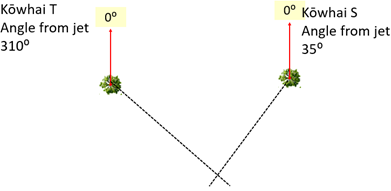
- Problem 5 is best solved using a set of compasses, like this. Draw arcs from each tree with the required distance set as the radius.
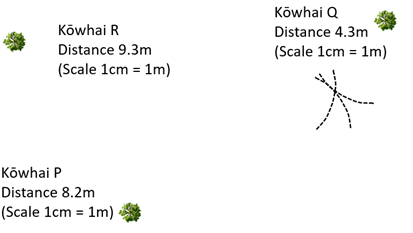
- The solution to Problem 4 should look like this. An important point is calculating the angle from the tree to the jet if you have the angle from jet to tree. A few examples, such as 35⁰ and 215⁰, 310⁰ and 130⁰, 100 and 280, will help students see that the reverse angle requires a one-half turn. Either adding or subtracting 180⁰ gives the ‘reverse’ angle.
Session Four: Protecting the cherries
- Use Slides One – Three of PowerPoint Four to introduce the scenario of establishing a cherry grove. Slide three shows the arrangement Gary and Kylie use to plant their trees.
What do you notice about the layout of the trees?
Why might Gary and Kylie have arranged the trees in that way?
What might be the advantage? What disadvantages can you see?
Students might notice that the trees seem to be planted in a circular formation. Possibly some students might suggest that all the trees can be watered by the same jet, especially since they only need deep watering once every week or ten days. - Find the best location to put a single jet to water these trees. Use what you know about the centroid to help you.
Give the students Copymaster Three to work on. - Roam the room as students work. Look for the following:
- Do they sketch an approximate circle through the points (trees)?
- Do they use the symmetry of the circle to approximate the centre (intersection of vertical and horizontal line of symmetry)?
- Do they use the grid to impose a coordinate system on the orchard?
- Can they represent the position of each tree using coordinates?
- Can they average the x-values and y-values to find the centroid?
- Gather the class after an appropriate time to discuss the points above.
Animate Slide Three of PowerPoint Four to check the ordered pairs are recorded correctly.
Challenge half of the class to average the x-values and ask the other half to do the same with the y-values.
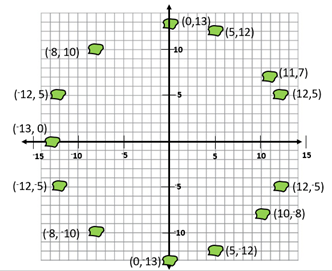
The x-values sum to 2. The average equals 2 ÷ 13 = 2/13 so the x-value of the centroid is 0.15. The y-values sum to --1 so the average equals -1 ÷ 13 = -1/13 or -0.08. The accurate coordinates for the centroid are (0.15, -0.08) but (0, 0) is very close and will do. - Let’s keep (0, 0) as the centroid.
Use the scale or Pythagoras’ Theorem to find the distance of each tree from the jet.
What do you expect to happen? - Let students work in pairs to find and record the distances.
Do they recognise that the distances are either exactly 13 metres or very close to it? Slide 4 illustrates the distances.
Do the trees lie on a circle? Explain why.
A circle is a locus (set) of points the same distance, the radius, from a fixed point, the centre. It makes sense that given the distance from the jet to each tree is nearly the same that the trees lie approximately on a circle.
Will this make Gary’s programming of the jet easier or harder? Explain.
What other information will Gary need to programme the jet?
Gary will also need to work out the angles.
Are any of the coordinates similar in some way? How are the points similar?
Students might notice that the points exist in families.
For example, the coordinates (5, 12), (5, -12), (-12, 5), (12, 5), (-12, -5), (12, -5) are very similar.
What points might be missing that would lie on the circle?
The points (-5, 12) and (-5, -12) are also in the same family. - Ask the students to work out the angle for each point using their knowledge of the families to save Gary (and themselves) work. Once they establish the size of one angle, say to the tree at (12, 5) encourage them to use that knowledge to work out the angles to other points without measuring. Slides 5 and 6 illustrate an example of doing so. Students will need to use benchmark angles such as 90⁰, 180⁰, 270⁰, and 360⁰.
Session Five
- In this session students conduct their own investigation.
In the last session you saw that Kylie and Gary could arrange the trees in a circle with the water jet in the centre.
Investigate using other shapes, such as triangles, squares, and hexagons.
Where is the best place to locate the jet?
What is the distance and angle from the jet to each tree? - Students may want to engage with the suite of learning objects called Plasers. Choose the version in which students choose coordinates first. The more difficult adaptations, such as recording a linear equation, are aimed at Level Five of the New Zealand Curriculum.
Dear family and whānau,
This week our class is investigating watering trees on a lifestyle block. The owners want to use programmable water jets to save water and accurately wet the trees and not the surrounding grass and weed.
Here is an example of setting out the trees in an octagonal shape.
Work with your students to find the best place to locate the water jet.
To programme the jet, you need a distance and a compass bearing (angle).
